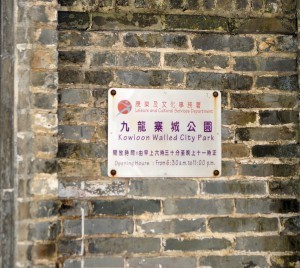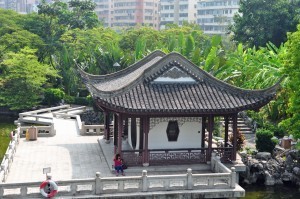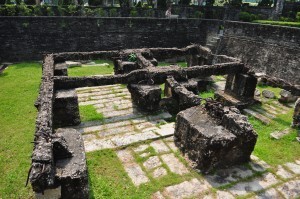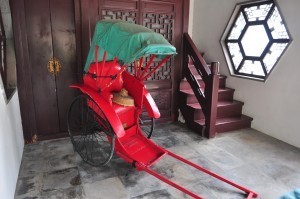Lisa Niver's Blog: We Said Go Travel, page 353
November 21, 2014
Wharton Business Magazine: Brandish My Gaming Badges
“One standout performance was by contributor Lisa Ellen Niver C89, whose latest blog tweet reached 4.1 million people.” (From Editor-in-Chief, Matthew Brodsky)
How Empire Avenue Taught Me to Brandish My Gaming Badges
 For most of my life, I have not considered myself into games. I was never good at Pong, and was there ever anything simpler than moving that one paddle up and down the screen? I tuned out when people talked about single person shooters, HALO and their favorite thing to do on Xbox. But when a friend suggested Empire Avenue, a stock market simulation social network game, I was intrigued. I loved everything about it especially watching my ratings and getting badges. Then I read the book Reality is Broken by Jane McGonigal, and I began to realize how much I have participated in games before this.
For most of my life, I have not considered myself into games. I was never good at Pong, and was there ever anything simpler than moving that one paddle up and down the screen? I tuned out when people talked about single person shooters, HALO and their favorite thing to do on Xbox. But when a friend suggested Empire Avenue, a stock market simulation social network game, I was intrigued. I loved everything about it especially watching my ratings and getting badges. Then I read the book Reality is Broken by Jane McGonigal, and I began to realize how much I have participated in games before this.
I have used many educational websites in the classroom as a teacher, and I was thrilled when I heard a fifth-grade student say, “Class was so great today. All we did was play.” This was in reference to playing CellCraft, where students have to save a cell from a virus. I loved when students were shouting at one another, “Where are the AA (Amino Acids)? I need to fix my cell wall.” They learned so much as they were enjoying it and moving up levels. Their main concern was beating the game and watching the score, not noticing all the content they learned.
McGonigal states, “Computer and video games are fulfilling genuine human needs that the real world is currently unable to satisfy. Games are providing rewards that reality is not. They are teaching and inspiring and engaging us in ways that reality is not.”
Game-playing inspires “fiero,” the feeling of vanquishing the “dragons” of the 21st century in a virtual world—a reaction that McGonigal describes as “one of the most powerful neurochemical highs we can experience.”

Digital badges are appearing in many forums as a way to inspire engagement. At the YMCA in New York City, teenagers who used to do no physical activity are suddenly showing up three times a week and earning a basketball Credly badge. They know that if they make baskets, they will receive another badge. They can see the steps toward a goal. Before, they would not get off the bench to stop texting, but now they are actively engaged in improving their health and in getting to the top of the leaderboard with the most points. Not only are these teenagers losing weight, some of their winnings are exchangeable for physical goods. Teens are happily sharing their badges and weight loss on Facebook and social platforms, and they are growing their support community in the process.
In Dallas, the Museum of Art decided that its goal was for people to engage with the art exhibits. No longer are visitors observing; they are active participants attending lectures, receiving codes and gaining points with Credly digital badges.
There are many ways we can create levels in life that have more privileges or rewards after engagement. In The Social Employee: How Great Companies Make Social Media Work, authors Cheryl and Mark Burgess explain how “gamification can mean a variety of different things, from earning badges through social training programs to interactive approaches for raising brand awareness to getting employees involved in things like product launches.”
With our work lives, gaining badges will tell future employers all about us as a digital portfolio. High school students can display badges about volunteering and scholastic experiences for university admissions departments to see.
Companies want engaged followers and brand ambassadors, schools want students who run into rather than out of the classroom, and museums want patrons who love art and rave about it. Democracy needs life-long learners who are passionate about their beliefs.
Are you ready to play a game?
The post Wharton Business Magazine: Brandish My Gaming Badges appeared first on We Said Go Travel.
November 20, 2014
A Camel Named Sky in Austria
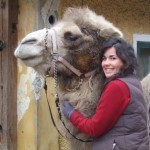
My life changed the night I met a camel named Sky. We met as I led him from the trailer in which he crossed the German border, under an Austrian winter darkness blank to heat and shattered with stars.
I arrived at the camel farm, in the miniscule town of Eintental, Austria, around midnight. Gerda, the camel lady, collected me from the train station, wearing a rainbow-colored beanie decorated with strands of straw. We would wake again in just a few hours, ready to muck out the stables of twelve horse and fourteen camels roaring for their morning feed.
Sky the camel arrived the night after. He was squat and fat compared to the lanky dromedaries craning their necks over the fence to scope the new arrival. He feared bridges (cause unknown) and loved children; within a month the two-humped teddy had become the star of the riding for the disabled program that was the basis of Gerda’s operation. Most of the camels she took in had been abused by the traveling circuses they featured in, whipped and tormented by ringmasters.
It all sounds like fable, which exactly why I chose to go there. I was in a hedonistic headspace: my mother was dead, my family fractured and the path I had anticipated was obstructed. I emailed my father, all the way back in New Zealand. I’ve decided to go to Austria and work on a camel farm. There was no reply.
But with Gerda I learned what strength really is. I had never undergone such hard physical labor. I mucked out stables for three hours each morning with hands puckered by blisters, until they grew calloused and my muscles gained sinew. I learned the precise art of flicking sawdust from a bucket to coat a stable, and how to shimmy feed under a camel’s nose without being bitten.
In the few months I spent on the farm I managed to saddle and ride a baby dromedary who came to Gerda so tortured that the mere sight of a whip would make him rear onto his hind legs and spit, thrashing around his stable and into the concrete walls. I thought that carrying a whip would help me to protect myself. But hurt things don’t need to be fought. They need to be won.
One night Gerda and I packed into the car and drove along the edge of the Danube. She refused to reveal our destination. We arrived in a neighboring town, at the house of an old and stooping man. Gerda wrapped an arm around him and tucked him into her side, and together they led me up the road to the cemetery.
We arrived at a particular headstone and the man began to speak, with Gerda translating. “This is the grave of my son,” he said. “He was paddling across the river in a boat with his fiancé when they were caught in a current. The boat flipped and they tried to swim away, but the water was too strong and he drowned.”
Gerda placed a candle on the grave, and lit it.
“If I had known that was gone,” she said, “I never would have kept swimming.”
On the drive home Gerda pulled into a pocket by the side of the river. “I don’t know what happened to you,” she said, “but you carry your sadness and it’s too heavy. I have so many animals because each time I see one that is lost, I think it might be the soul of the man I loved. When I realize it’s not, it’s like loosing him all over again.”
“Don’t become a sad old woman like me,” she said, pulling back onto the highway. “You are alive, and whoever you lost wants it that way. So live.”
I have come to believe that it is in the strangest moments that we discover who we have the potential to become. Not the worst: I knew exactly who I was when my mother died, even if I didn’t like it. What her death lacked was definition: I had to ask if she was gone. My grandmother was crying and said nothing, which I took as an answer. She brushed the hair back from my mother’s forehead and folded into herself with resignation.
My grandmother has forgotten most of this. I think that’s when she gave up. In her new, strange wilderness of memory she is discovering what she has the capacity to be: happy.
I am grateful for each fragment of my life, carried as a universe within. Once, I was an assistant camel farmer to a woman named Gerda, who taught me everything. Like, how to let my parallels coexist. How to be strong without being hard.
How to grieve without forgetting.
Thank you for reading and commenting. Please enter the Gratitude Travel Writing competition and tell your story.
The post appeared first on We Said Go Travel.
USA Today: The Nest at WP24 @TheRitzCarlton
The Nest at WP24:
Food for the Gods at The Ritz-Carlton
Discover tantalizing treats with one of the best views in Los Angeles
By Lisa Niver
Los Angeles Local ExpertOCTOBER 28, 2014
SAVE TO MY LISTS
In Los Angeles, your dining choices are as varied as the stars in the sky. Choose to spend your evening with our very own celebrities — the LA Kings ice hockey team and Wolfgang Puck — by dining at the Nest at WP24.
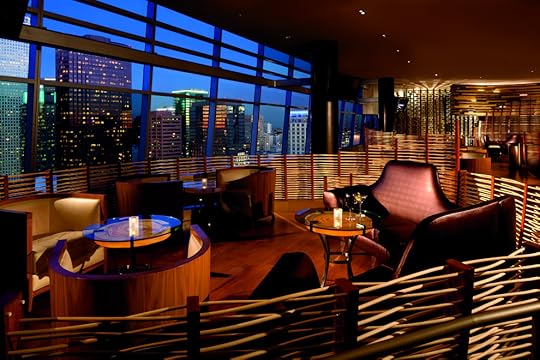 Stunning nighttime views from the Nest on the 24th floor of The Ritz-Carlton
Stunning nighttime views from the Nest on the 24th floor of The Ritz-Carlton
Photo courtesy of Don Riddle / The Ritz-Carlton
The Nest is a premier dining location located on the 24th floor of The Ritz-Carlton, next to the Staples Center. Here, you can “Puck and Play” before you watch the 2014 Stanley Cup Champions take the ice. Enjoy the stunning view and a special pre-game menu, with a choice of three unique dim sum creations.
Options include the shrimp and lobster spring roll and pork belly bao bun, and main course favorites include jumbo prawns, jidori chicken stir fry and lap chung sausage fried rice.
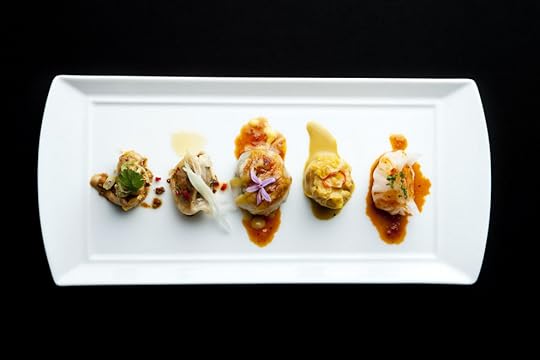 Delightful dim sum creations for “Puck and Play”
Delightful dim sum creations for “Puck and Play”
Photo courtesy of Nest at WP24
WP24 Restaurant, which houses the Nest, is the fine dining restaurant on the 24th floor of The Ritz-Carlton, and like the unique luxury of the hotel, Wolfgang Puck is serving a special Alaskan King Crab menu.
 Delicious appetizers for starting your meal at the Nest
Delicious appetizers for starting your meal at the Nest
Photo courtesy of Lisa Ellen Niver
Do you like to see your dinner first? Your evening begins with a tableside presentation of the live crustacean in the traditional Asian fashion, which is also to guarantee the freshness of preparation as your five-course menu gets underway. One king crab will generally feed four to six guests.
After four seafood courses, your fifth course includes the Red Cooked Pineapple Cheesecake with lemongrass, passion fruit and coconut.
As Chef De Cuisine John Lechlediner says, “We wanted to offer guests the ultimate king crab dining experience, rich with bold flavors and spices that bring out the best in this delicacy.”
Most king crabs are caught off the coasts of Alaska and Russia in some of the most dangerous conditions in the world. King crabs can have legs up to three feet long and weigh up to three pounds.
WP24 Restaurant showcases Wolfgang Puck’s award-winning modern Chinese cuisine. Klaus Puck, Wolfgang’s brother, is the operations partner at Bar&Grill and WP24 Restaurant of this location. More than 400 labels of wine complement the intricacies of the food and the fresh herbs from the garden.
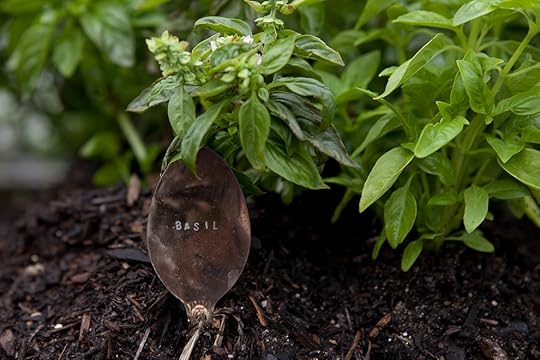 Basil grown in the garden comes to your plate freshly picked from one floor up!
Basil grown in the garden comes to your plate freshly picked from one floor up!
Photo courtesy of Nest at WP24
Senior Bartender Alonso Jones has been creating new specialties for your libations, which include herbs from The Ritz-Carlton garden. His signature “OMG” includes orange, mint and ginger; it can be served with or without gin.
Step into the Nest at WP24, with its stunning panoramic views of the city, and discover the other new cocktails specifically fashioned by the local team from the garden.
Locals know that the Nest at WP24 and WP24 Restaurant are perfect for a small gathering of friends or a larger event. Enjoy the luxury of this location, and make it to your seats in time to cheer on the championship Kings!
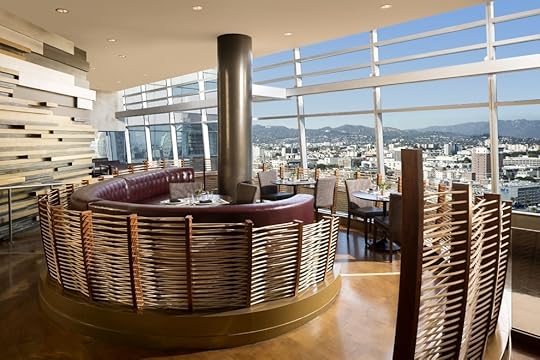 Enjoy the Nest at WP24 during daytime
Enjoy the Nest at WP24 during daytime
Photo courtesy of Nest at WP24
x
FEATURED ARTICLE
Rodeo Drive: Iconic and Historic Shopping in Beverly Hills
The post USA Today: The Nest at WP24 @TheRitzCarlton appeared first on We Said Go Travel.
November 19, 2014
In the Footsteps of the Argyll in Malaysia
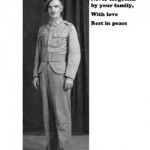
I never knew Great Uncle Ron. He was killed in Malaya (as it then was) in 1941, serving with the Argyll and Sutherland Highlanders. But the very mention of his name to any of the older members of the family would elicit the same response. Verbatim. “You would have loved, Ron.” He had suffered from TB as a teenager and was considered infirm, so was delighted to be accepted for active service at the age of 25 in order to prove to himself, as well as to others, that he was fighting fit. He was to die before his 26th birthday.
Skip forward to Christmas 2001. For once, myself, my two brothers and families are at my parents’ house. Talk after dinner turns to family stories and Uncle Ron makes his appearance.
“You would have loved Ron,” my father begins, telling us that he still had the telegram detailing Ron’s death somewhere and goes up to the attic to look for it. Ron had been killed by a shell in Battalion HQ twenty miles south of Ipoh, Malaysia. The date the fatal shell fell was 29th December 1941. Sixty years to this very day, 29th December 2001, exactly sixty years to the day that he fell. My Dad had ’t looked at the telegram for a while; it was in a box he hadn’t opened since my Grandfather passed away. It was strange that it had happened when all the family, for once, were gathered, as if Ron was nodding to us from beyond. Then and there I swore that one day I would go and put some flowers on his grave on behalf of the family. My Dad was touched.
“You would have loved Ron,” was his reaction.
It was another ten years until I could do what I had promised , my father, by this time, visibly frailer each time I saw him, his body riddled with cancer; too frail to travel, but not too frail to instruct me to take lots of pictures. Some friends were living in Jakarta, close enough to Taiping to combine a visit with my family pilgrimage. I was to make the trip with my friend. His wife made the bookings. She was good at that sort of thing.
Having followed by bus the route the Argylls took north to Ipoh in the state of Perak, fourteen hours after leaving Jakarta, we found ourselves beside a quiet dual carriageway waiting for a taxi. After an hour or so one stops. Unfortunately the driver does not actually know Ipoh very well and spends two hours looking for the hotel, phoning friends for assistance and creasing up his face in confusion when we show him our map. Many phone calls, numerous enquiries of other drivers and scores of circles later we get to the hotel. “No pets and no durians,” proclaims the sign at reception. Ipoh was a tin mining town, and this, along with rubber plantations, once provided great wealth. Not now though. Its centre is resplendent in crumbling grandeur in pastel shades. The only building still clad in its colonial elegance is the Royal Ipoh Club, the name spelled out in white stones on the flowered bank overlooking a lush expanse of playing fields where cricket, polo and rugby were once played. It looks haughtily down in its mock Tudor grace on ramshackle facades of formerly beautiful buildings and pavements that tilt at every angle, open drains and potholes that could swallow you up to the knee. The classically Victorian train station hotel is, like so many others, closed with some of the shutters hanging precariously from one hinge. It is here that Ron would have disembarked from a train on the Kuala Lumpur to Butterworth line.
A perfect lawn and lines of gravestones laid out in neat rows. A palm lined avenue leading to a memorial, while gardeners dressed in green cotton overalls, with straw hats, silently tend the immaculate cemetery which is laid out on both sides of the road. Ornate gates face other across the tarmac. 329 known casualties from Indian, British and Commonwealth armies rest here along with 500 unidentified troops. Most of these seem to be “An unknown soldier of the Indian army.”
My Dad, who passed away last year, couldn’t thank me enough. Why do sons always crave the approval of their fathers? A good few more you-would-have-loved-Ron’s later and several I-can’t-thank-you-enough’s and for all those who did, and those who would have loved Ron, the flowers were laid. And through this travel, reading the letters he sent, researching the history of his regiment, in following in his footsteps from Singapore to his last resting place in Taiping, even though I never met him, maybe, just maybe I did get to know him… just a little.
Thank you for reading and commenting. Please enter the Gratitude Travel Writing competition and tell your story.
The post In the Footsteps of the Argyll in Malaysia appeared first on We Said Go Travel.
November 18, 2014
Leaving the Comfort Behind in Thailand
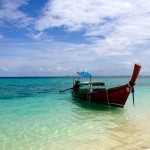
Leaving the Comfort Behind in Thailand
My Thai taxi driver and I zoomed down the highway from the airport at record breaking speeds. Passing through tollbooths so fast that if you blinked, you’d miss the exchange of money. There wasn’t much to see out the window, so I attempted a conversation with the driver. He spoke about 15 words of english and I spoke about 2 phrases of Thai. The conversations were brief and filled with lots of laughter at our feeble attempts at communication. I felt like I was in a smog filled dream as we drove. How can I be here? After all these months of planning and talking about it, the time is now. It’s been rough. Let me just say, choosing to leave behind any level of comfort is hard. Personally, I left behind a town that I had finally gotten used to, friends i love and cherish, and my very cozy room on the second floor of a beautiful blue farm house surrounded by goats and horses. Why do any of us choose to leave behind the lives that we’ve spent some of our most formative years building? And, is it worth it? I’ll get back to you on that one.
Flash forward 2 weeks, and as we left Railay beach after an afternoon of boats serving us beer and pad thai along the shore, a storm came in. We waited under the shelter of a small structure with about 20 other tourists, the storm brewed stronger and stronger. “Time to go!”, our boat driver told us. “Right now? Alright…” we all said as we exchanged worried looks and nervous laughs. We grabbed our belongings and tried helplessly to shelter our belongings with our bodies and make the walk out to the boat. When we had arrived earlier, the boat had taken us straight to shore, but at that moment, we found out how drastically the tides change in Railay. We shuffled along with lightning striking the mountains around us. We feverishly attempted to stay on the broken remains of a sidewalk that laid about 2 feet beneath the murky ocean water. We led the group of tourists and moved slowly, trying not to trip. Once safely back in the boat, we shivered and laughed and sat impatiently as we took the cold longboat ride back to Krabi. We longed for those enticingly hot showers in our surprisingly chic hostel. My friend inspected her wound and we huddled under the thin top on the longboat. Oh, did i mention this had been right after my 8 hour overnight bus from Tak to Bangkok, my 1 1/2 hour flight from Bangkok to Krabi?
Thailand is a land full of surprises, and definitely not always the good kind. If you want to live here, you better have a good sense of humor. Sh*t happens. You gotta be able to roll with it and laugh along the journey. After my brush with an ocean monsoon, the days in the islands turned more and more into what I had imagined. Days spent lazing around by a pool, drinking sugary Thai cocktails (they add sugar to EVERYTHING), frolicking in beautiful azure waters with towering limestone cliffs making up the backdrop. I spent the bulk of my trip in Koh Phi Phi which is an island that’s small, beautiful, and full of tourists. I’ll save you the stories of my Koh Phi Phi debauchery, primarily because my mother might read this. I will say that I made some amazing friends from all over the world, got to limbo under fire, stand on the same beach Leonardo DiCaprio stood in the Beach (along with about 300 asian tourists), ate a lot of seafood, etc. I trust you get the picture; it’s a pretty fun place to act like a carefree backpacker.
I want to express is how terrifying it can be to make such a leap of faith into a new country and life, as temporary as it may be. But, also the fact that the most terrifying choices we make, tend to be the most memorable and most rewarding. I chose to teach abroad because I didn’t want to just be another backpacker in Southeast Asia. If you have the opportunity and means, why not really LIVE somewhere? Spend some time getting to know a new group of people, a new culture, a new lifestyle, and you will be rewarded with finding a deeper meaning in yourself as well. All of us have reasons we can come up with about why we can’t travel or take these risks. Here’s the thing, if you want it bad enough, you can make it happen.
Author’s Bio: Hailing from the big city of Chicago, Chandler craves oceans, mountains, and the perfect sandwich. She has a long list of places to see before she dies, but first, another episode of this show sounds just fine.
Thank you for reading and commenting. Please enter the Gratitude Travel Writing competition and tell your story.
The post Leaving the Comfort Behind in Thailand appeared first on We Said Go Travel.
USA Today: Finding Peace in Parks Is Possible in Los Angeles

PARKS
10. San Vicente Peak
Photo courtesy of Mike Hume

PARKS
9. Clover Park
Photo courtesy of samolive.com

PARKS
8. Lake Balboa
Photo courtesy of chiquibaylon.net

PARKS
7. Holmby Park
Photo courtesy of Lisa Ellen Niver

PARKS
6. Will Rogers State Historic Park
Photo courtesy of www.image-archeology.com

PARKS
5. Self-Realization Fellowship Lake Shrine
Photo courtesy of commons.wikimedia.org

PARKS
4. Westwood Recreation Center
Photo courtesy of www.laparks.org

PARKS
3. Greystone Mansion and Park
Photo courtesy of Tom Fox

PARKS
2. Palisades Park
Photo courtesy of Lisa Ellen Niver

PARKS
1. Original Muscle Beach
Photo courtesy of Lisa Ellen Niver
 By Lisa Niver
By Lisa NiverLos Angeles Local Expert
SAVE TO MY LISTS+
Whether you choose Los Angeles as your home or vacation destination, we all need some time in the outdoors to revive and feel more alive. This list of peaceful parks includes venues with ocean views like the original muscle beach and Palisades Park as well as Lake views at either Lake Balboa or Self-Realization Fellowship Shrine.
In the search for peace and harmony, there are many choices for green spaces in Los Angeles as well as a chance to learn about history at Will Rogers State Park. You can sit and contemplate, bring a picnic or enjoy many of the areas with special play areas for children.
Los Angeles may often be on the news for our traffic, but we should be better known for our outdoor choices! You can relax and unwind all over our beautiful city in many green spaces that are places to feel free and enjoy the outdoors and allow for peaceful relaxation and contemplation. If you are looking for a romantic spot for a date or proposal, this variety of venues should do the trick all over our unusual city. My friend proposed to his girlfriend at Westwood Recreation Park, but I can see that nearly every venue on this list could be a perfect spot to pop the question in a park! Enjoy your time in Los Angeles! Special Thanks to Joannie Parker, Shirin Yadegar and Amy Gendel Bowen for their help and suggestions!
10 San Vicente Peak
You can drive, bike or hike to this area. They have a bathroom, water dishes for dogs, shade and picnic tables! It is located at the top of Kenter and has a viewing platform with telescopes. It is in the Santa Monica Mountains and has 360 degree views of the Santa Monica Mountains, the Encino Reservoir and San Fernando Valley, and the Los Angeles Basin. Marvin Braude Mulholland Gateway Park, Westridge Canyonback Park, and the 20,000-acre “Big Wild” wilderness area, are all accessible from San Vicente Mountain Park. From 1956-1968, San Vicente Mountain was one of sixteen Los Angeles area Nike-Ajax supersonic anti-aircraft missile launch sites. Established during the Cold War, this site had radar and computer systems to detect attacks by plane and missiles. I love to hike here! ((310) 858-7272)
9 Clover Park
This park has areas where you can walk, run, exercise, relax, picnic, and play soccer or baseball. There is plenty of parking and you can reserve the large barbecue pit. Children can enjoy swings, jungle gym as well as fields for ultimate frisbee, baseball and soccer. Adults can take advantage of work-out equipment through-out the park for more serious exercise on the 15 station par fitness course. The baseball diamond, softball fields, soccer fields and two tennis courts all have lights so this area is not just for daytime use! Wondering where to play sand volleyball but not at the beach? This park might be your top choice! You will find locals here and visitors to Los Angeles will consider this a great find!
8 Lake Balboa
I went rollerblading here once and realized it is a bit more hilly than I first thought! The area around the Lake is beautiful, you can enjoy the cherry blossoms or people watch! Remember if you want to picnic, there are not stores within walking distance of the park, so come prepared. There are many different play areas, plenty of free parking and lots of open space for walking, bicycling and outdoor fun. Lake Balboa is a 27 acre lake filled with water reclaimed from the Tillman Water Reclamation Plant. Enjoy many different activities like fishing, boating, remote-control boating or staring at the beautiful scenery. Main access is from Balboa Boulevard. ((818) 756-9743)
7 Holmby Park
This park has it all: a stream, separate sand and play areas for different age children, a track for running or biking and it is just really pretty! And they even organize a fantastic 4th of July party and parade The “pitch and putt” golf course is a perfect place to take beginning golfers and there is lawn bowling for the seniors. At this park: 1 lap is 5/8 mile and 2 laps is 1 1/4 mile. 8 laps around the entire park is equivalent to 5 miles. Famous sites nearby include “The Manor” (the old Spelling mansion) is across the street and the “Playboy Mansion” is a few blocks away. Holmby park is just north of Wilshire Boulevard, at the intersection of Beverly Glen and Comstock. There is convenient free street parking (2 hours) all around the park. ((310) 276-1604)
6 Will Rogers State Historic Park
Parking is $12 but if you arrange it on a day where you can take a tour of Will Rogers’ house and see a game of Polo, who can complain! There is limited street parking but you will have about a ten-minute walk. For the hiking, please read the signs and follow the trails. I have heard some issues in the summer with ticks. Be careful and pay attention. Try Inspiration trail but remember that the Chicken Ridge is located on the Backbone Trail. I have heard that Rustic Canyon Trail needs some maintenance. You can also run around the polo field. Docents lead tours of the home but you are not allowed to take photos inside. It is quite of museum of his original possessions! There are horses on the grounds as well as a few original vehicles and machines. (310-454-8212)
5 Self-Realization Fellowship Lake Shrine
Children and adults are welcome to enjoy the gardens and lake for meditation, fish feeding, or a quiet place to sit and reflect. This is “LA’s best kept secret. A serene place to spend quality time with your children,” according to CEO of LA Mom Magazine, Shirin Yadegar who has lived in Los Angeles her entire life. The Self-Realization Fellowship Lake Shrine was dedicated by Paramahansa Yogananda in 1950. Thousands of people enjoy this serene spiritual sanctuary every year. There are swans, ducks, koi, and trees and flowers from around the world. The grounds include a Court of Religions honoring the five principal religions of the world, the Mahatma Gandhi World Peace Memorial, a museum with exhibits on Paramahansa Yogananda’s work, and a gift shop with arts and crafts from India. The temple is on a hilltop overlooking the lake. (310-454-4114)
4 Westwood Recreation Center
It has a lot of empty space for picnicking, It has multiple play areas for the kids, and a basketball court for the big kids. Where else can you play soccer, tennis, basketball, and picnic, practically next door to a federal building! Westwood Recreations Center is also the second West Coast Boundless playground created by L.A. Recreation and Parks in conjunction with the Boundless Playground Resource Center West. Aidan’s Place (located here) opened on December 5, 2001 in memory of Aidan James who was wheelchair bound. It’s also special because it’s where my friends, Amy and Rolando, got engaged in 2010. Maybe this park will bring you love and romance too! ((310) 473-3610)
3 Greystone Mansion and Park
Not your typical park as you won’t find a sandbox, swingset or dog run anywhere. What you will find is a a sprawling mansion, with beautiful gardens and stunning views nestled above Sunset Blvd. From its hilltop location, Greystone offers spectacular views and a quiet retreat from the busy city. Formal gardens, winding paths, and huge redwoods create a rarefied atmosphere that is at once calming and invigorating. Wander the grounds and look in the windows of the 1928 Doheny Mansion (listed on the National Registry of Historic Places). You may have seen the mansion and grounds in your favorite movie or noticed it in films like “Indecent Proposal” and “The Witches of Eastwick.” The mansion is only open for special events. The grounds are generally open to the public, and there is free parking. Thank you to Amy Gendel Bowen for introducing me to this special spot! (310-550-4654)
2 Palisades Park
Palisades Park is a gorgeous park in Santa Monica that is right next to the coastline and encompasses over 25 acres. It’s beach front location provides visitors to the park with views of the ocean. Watch the sunset, observe some surfers or simply enjoy the rhythmic nature of the waves. Palisades Park is home to walking paths and is dog friendly, making it an ideal place to hang out for awhile if you’re traveling with your dog. Yoga is also a common sight to see in the park — if you’re a yogi bring your mat and get centered in the nature-filled wonder of Palisades Park.
1 Original Muscle Beach
A park at the beach? Only in Los Angeles! Wondering what there is to do here? Enjoy the hooping skills of Katie O’Brien Eychis and her circus star friends. You can also see acro-yoga, kick boxing, slack lining and people with incredible skills on the rings. This area is happening day or night. I love the green grass area right next to the gorgeous Santa Monica beach. As it is located next to Santa Monica pier, there are plenty of restaurant choices, bike paths and bike rentals. You can even learn to segway in the area. Famous hotels like Loews Santa Monica, Shutters and Casa Del Mar are nearby if you want to vacation right at the beach. ((310) 458-8901)











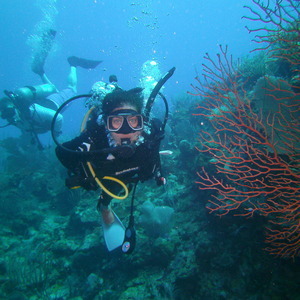
The post USA Today: Finding Peace in Parks Is Possible in Los Angeles appeared first on We Said Go Travel.
November 17, 2014
Cemented Cultures in Sarajevo, Bosnia
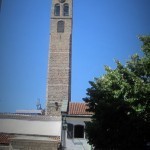
I arrive in Sarajevo knowing practically nothing about it. Tired and disorientated, my friend and I joke that it must be a decent place to visit since Bosnia and Herzegovina has competed in the Eurovision. Disembarking the rickety train from Serbia, we have no map, but the name and reservation number of a hostel.
Amna, a middle-aged maître d’, greets us outside a stark residential tower, where clothing dangles from many open windows. With voracious gusto she carries our bags up several flights of stairs till we are outside what was advertised to us as a hostel. Its extreme modestly is not what we expected. We find ourselves standing in a single room apartment, dwarfed by the presence of three bunk beds, each lining the wall. Amna senses our discontent because before we say anything she briskly insists on lunch at Burekdžinica ASDž, an apparent local favourite. It is over a meal of Ćevapi – Bosnian kebabs – that we get a real taste for Sarajevo and its turbulent past.
“You know,” she begins, “you know what happened here?” We awkwardly glance down at our Styrofoam plates of onions, sour cream, ajvar, and pita, to conceal our embarrassed looks.
Setting aside her fork, Amna takes time to tell us about the Bosnian War. She starts by recalling the hope she had when Yugoslavia dissolved. Her future was abruptly clouded when the Bosnian Serb forces brutally took siege of the city, in April 1992. A bloody genocide raged on for three years, resulting in the death of thousands.
She despondently tells us how her life had changed while she was doing her studies, explaining, “We were the new Republic of Bosnia and Herzegovina for so little time before the Serbs destroyed everything. My home is no more, my family lost everything, and I didn’t finish my school.” She sombrely continues by telling us about the home and belongings she left behind. Her house is now a deserted shell, standing in the outskirts of the city and her processions have long been stolen.
With this heavy meal and heavier story to digest, we part ways. My friend and I climb aboard a battered tram, smelling of smoke and ancient leaves. Inside, a distressed toddler competes with the tram’s stridulating sound as it moves along the track. After Amna’s story we notice the dilapidating buildings which stand on either side of us, with their paneless windows and crumbling bullet holes.
We get off the tram when the driver gruffly shouted “Center” over the crackling intercom. It was then, standing in the Ottoman quarter that Sarajevo’s secularity quickly strikes us. The rounded domes of Ottoman architecture are a stark contrast to the communist blocks, looming on the outskirts. I hear the undulating sound of the ezan, while passing the gothic Sacred Heart Cathedral and can’t help but laugh at the juxtaposition. By following the sound, we find Gazi Husrev-bey Mosque. Under the sun it stands surrounded by people in prayer, kneeing on thread bead mats.
As we roam the streets, lined by low-lying eateries, cafes, and curiosity shops, we are cajoled by the restaurant proprietors who lazily scratch and stretch in the heat. Impatiently, they wait for people to break their Ramadan fast and for festivity to fill the air. A rotund man with a sweating lip coaxes us into his establishment. He is gracious until we ask for beer. In response he throws up his hands, repeating “Ḥarām” and leaves the restaurant. Moments later he reappears with a woman, carrying two beers. She sits them on the table and explains, “You come pay me for these after” and points to an Italian take-away a few doors down.
That evening we mount the Yellow Fortress to find placid Muslim families, assembled under trees. The lambent light illuminates the hazy outlines of churches, mosques and synagogues, which are nestled in the great valley surrounded by the Dinaric Alps. From this vantage point Sarajevo really resembles a melting pot of the world’s great religions. With the Ottoman in the south, Orthodox in the east, and Roman Catholic in the west, the diverse population lives and has collided.
It is hard not to be moved by the resilience and strength of these people. After three years of savage killing, the disparate creeds of Sarajevans managed to eventually reconcile their differences. The city exemplifies the importance of cultural tolerance, which we can so easily take for granted. While the aftermath of such atrocity is embedded in the nations’ consciousness, this city is the beacon of hope and peace.
Behind us a canon is shot to mark Iftar. We venture back into the centre where a sense of festivity is contagious, irrespective of religion. The din of families eating is heard from every restaurant. Some with beers, some without.
Thank you for reading and commenting. Please enter the Gratitude Travel Writing competition and tell your story.
The post Cemented Cultures in Sarajevo, Bosnia appeared first on We Said Go Travel.
Hong Kong: Kowloon Walled City Park
When I first moved to Hong Kong in 1990, there was a part of the city that was off bounds. It was an ungoverned slum called the Kowloon Walled City, with layer after layer of tenement buildings so close to one another that daylight sometimes never reached the minuscule alleyways. In the center of the slum was an ancient Chinese yamen, or government building. Although Hong Kong had been a British colony for about 140 years by then, the Kowloon Walled City was officially still a part of China. But it was largely run by organized crime.
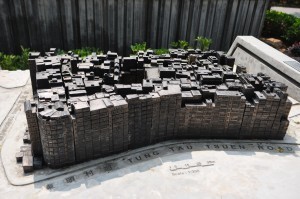
Model of the Kowloon Walled City. Photo by Tom Kason
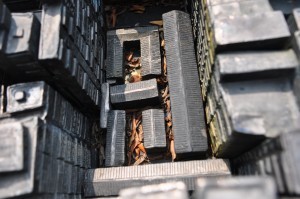
Model of the yamen. Photo by Tom Kason
I left Hong Kong in 1991, only to return a few years later in 1994. By then, the Walled City had been demolished and a traditional Chinese park was under construction on the very space where the slum once stood. I often passed the general area of the Walled City–after it was demolished–on bus rides to and from my friend Janice’s apartment. I write a little about Janice’s place in my memoir, Good Chinese Wife: A Love Affair with China Gone Wrong, but was so involved in my own drama back then that I didn’t give the old Walled City or the new park (when it opened in 1995) much thought.
Years have passed since I left Hong Kong eight months after the Handover in 1997. But I’ve often thought of the Kowloon Walled City and a missed opportunity to 1) see the old tenement buildings, 2) watch the demolition, and 3) visit the new park.
So when my husband Tom and I visited Hong Kong last month, I put a visit to the Kowloon Walled City Park at the top of our list. We traveled out to the Lok Fu MTR station and took a cab to the park. On the short ride, the driver told me in Cantonese that we should have just walked to the park. It was that close. But I didn’t want to waste time looking for it and Tom wanted a break from the sweltering temperatures. Once we arrived at the park, it was difficult for me to imagine the former Walled City in its place. The park was one of the most peaceful places I’ve found in Hong Kong.
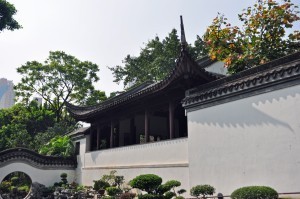
photo by Tom Kason
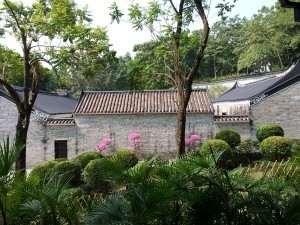
yamen
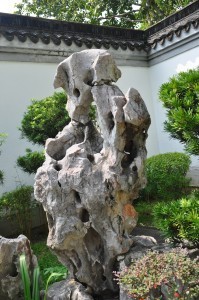
photo by Tom Kason
We walked around the grounds and found a garden with statues of the Chinese zodiac.
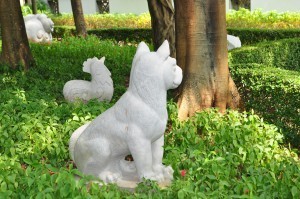
photo by Tom Kason
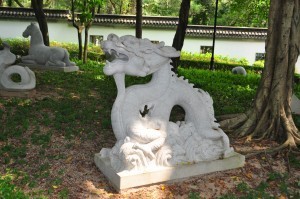
photo by Tom Kason
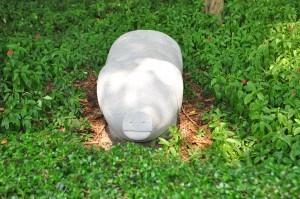
photo by Tom Kason
There was a nice pavilion surrounded by water. A woman sat under the pavilion reading a book. I wondered if she was taking a break from work or chose to spend her day off at the park. I also noticed the modern apartment buildings in the background, many of which probably weren’t around when I first lived in Hong Kong.
We also found remains of the old south gate and an old rickshaw, one of the few left in Hong Kong. Even the tourist ones aren’t so numerous anymore.
We also came across a few walls with calligraphy and this old vessel.
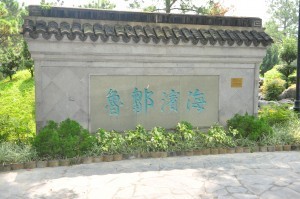
photo by Tom Kason
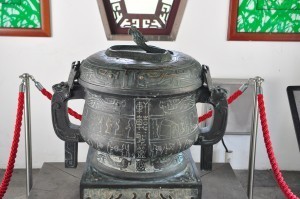
photo by Tom Kason
Tom and I were both happy we’d taken time to visit the Kowloon Walled City Park. He learned about a dark period of Hong Kong’s history and I was able to visit a place I’d thought about all these years. For first time visitors, there are docents who walk throughout the park, offering free information about the history of the buildings and artifacts in the park. We lucked out and met a lovely older Cantonese man who spoke to us in English and another group in Mandarin.
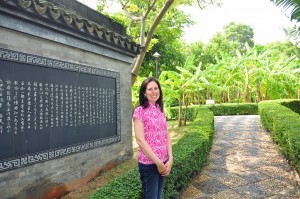
photo by Tom Kason
We hope you enjoyed this article from Susan Blumberg-Kason. Learn more about her adventures in her book:
Good Chinese Wife: A Love Affair with China Gone Wrong
The post Hong Kong: Kowloon Walled City Park appeared first on We Said Go Travel.
November 16, 2014
Injasuthi – Hair of the Dog, South Africa
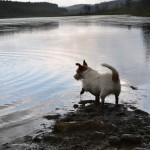
Injasuthi – Hair of the Dog
The wild little dog snarled and nipped at my heels as I manhandled the two-man croc into the water. Overhead the clouds growled like a large, plaintive stomach as the Injasuthi river snatched up the rafts like small, yellow treats.
The well fed dog, or rather the Injasuthi, winds down the Dragon Mountains of KwaZulu Natal in South Africa and offers the adventure seeker a thrilling river rafting experience – if one dares to tempt the hound.
The icy water bit my ankles as I squeezed my rear end between the pontoon sides. I grabbed at the paddle and thrashed it at the dog to prevent it pulling me into faster waters. For now we were to SIT and STAY; to await the guide’s instruction to HEEL at his command.
One by one the inflatables bucked and spun their way through the first couple of rapids, white water snapping at our faces like many sharp white teeth.
A thunk against my helmet alerted me to a pack of local youngsters enjoying a bit of sport with the rafters. They howled and yelped their delight each time a projectile made contact with a paddler or when the little dog grabbed a participant and tossed them about mercilessly. Once the stone throwing had lost its appeal, the pack kept pace with the paddlers, trotting along the banks above, baying with laughter.
At the next rapid, the little dog swallowed the first raft, then the second and as mine approached the drop off, the remains of upturned rafts cycling in the water greeted me.
Panic!
My raft folded in two and spat its occupants into the belly of the beast. It was as if I was being pressed down by a giant paw as the pressure from the waterfall held me under. With oxygen being rapidly utilized through fright and flailing, my lungs burned as I clawed my way upwards through the water. I felt the graze of the emergency rope on my knuckles as it was thrown into the maelstrom. My panic swelled when I pulled on the rope and there was no pressure behind it. Discarding the flaccid appendage I managed to grasp a piece of nylon. Salvation! I hauled myself upwards as my life depended on it.
I surfaced beneath an upturned raft boiling on the surface of the tumultuous waters beneath the rapid. I gulped wet air into my furry lungs until thought returned. I was yet trapped in the obstacle and would need to push myself out from under the raft. It would entail me allowing the dog to sink its teeth into me once more.
Pushing under and away from the raft, my head pressed up against the underside of yet another raft. Clawing frantically now to manoeuvre myself past this impediment I felt the delicious relief of someone grasping my lifejacket from the back and physically prying the dog’s jaws from me. I was hauled unceremoniously out onto the rocks.
I lay limply, my ragdoll limbs unable to move. No thought, only breath passed through my body. After some time I crawled over to the small brown beach where I shook and cried weakly. I was determined to end this adventure; I insisted I would walk back.
The guides wore sympathetic faces, but in this corner of Africa, we were too far away from anywhere for me to consider walking. There were no roads for a vehicle to collect me either. I would have to face the vicious little dog again.
It was on that particular brown beach that I found within myself the courage to continue after being beaten down. I had survived the rabid dog without succumbing to its disease. I was after all: gratefully alive and breathing! I appreciated the sweet air I was inhaling and the firm ground under my feet. I was exhausted but not defeated. I could do this! I would call the dog to HEEL.
The pack of little boys had found my paddle. They quietly crept up to this now contemplative woman and held it out like a peace offering, like an apology.
I gave them a shattered smile and they gibbered happily away in Zulu – the game was again on!
There is now, indelibly imprinted on my mind, a certain brown beach along a fat little dog where I am grateful that I know my strength, my courage, my inner hero.
Pronounced: In-juh-sue-tea
Injasuthi is Zulu for the ‘satisfied dog’ as in: well fed.
About the author: I love my name Kerrith, but prefer to call myself Kerry! I have a healthy appreciation of how overcoming challenges in life sets a person free. Overlanding and adventuring through a fair bit of Africa, I’ve learned that unplanned events can often be the most liberating!
Thank you for reading and commenting. Please enter the Gratitude Travel Writing competition and tell your story.
The post Injasuthi – Hair of the Dog, South Africa appeared first on We Said Go Travel.
USA Today: Tee’s On the Green
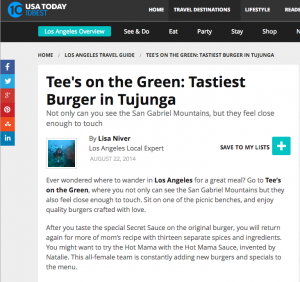 Tee’s on the Green:
Tee’s on the Green: Tastiest Burger in Tujunga
Not only can you see the San Gabriel Mountains, but they feel close enough to touch
By Lisa Niver
Los Angeles Local ExpertAUGUST 22, 2014
SAVE TO MY LISTS
Ever wondered where to wander in Los Angeles for a great meal? Go to Tee’s on the Green, where you not only can see the San Gabriel Mountains but they also feel close enough to touch. Sit on one of the picnic benches, and enjoy quality burgers crafted with love.
After you taste the special Secret Sauce on the original burger, you will return again for more of mom’s recipe with thirteen separate spices and ingredients. You might want to try the Hot Mama with the Hot Mama Sauce, invented by Natalie. This all-female team is constantly adding new burgers and specials to the menu.
 Which burger will you choose at Tee’s on the Green? They are all delicious!
Which burger will you choose at Tee’s on the Green? They are all delicious!
Photo courtesy of Lisa Ellen Niver
Owner and Chef Tiffany Casper was always in search of the perfect burger with a special bun, tasty meat and fresh toppings, she researched all the best ingredients to create what she personally had been missing. Growing up with her mom’s special sauce at home, she was only going to accept top quality.
While Tee’s on the Green is on the edge of Vergugo Golf Course, the food is so good that this is not just a spot for after a round of golf. The fresh Angus meat is prepared daily, no freezing at this establishment, as it distracts from the taste of the tempting taste sensations.
The buns used here arrive daily from a bakery Tiffany used to work at, and some are especially created to her specifications, especially the jalapeño cheese bun. She has used exceptional effort to bring her high standards to the community.
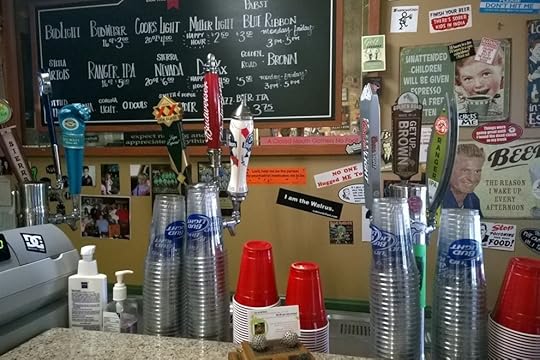 With 11 beers on tap, there’s a perfect choice for every taste
With 11 beers on tap, there’s a perfect choice for every taste
Photo courtesy of Lisa Ellen Niver
After moving to La Crecenta from Massachusetts when Tiffany was nine, she discovered Vergudo Golf Course and even worked in the golf snack bar, The Putt Stop, as a teen. It was always a secret dream to fix the place up. When The Putt Stop closed, it was time to go to work.
Her labor of love has created a community of food lovers that are tempted with 11 beers on tap, wine, wine coolers and hard cider to accompany the truly amazing burgers!
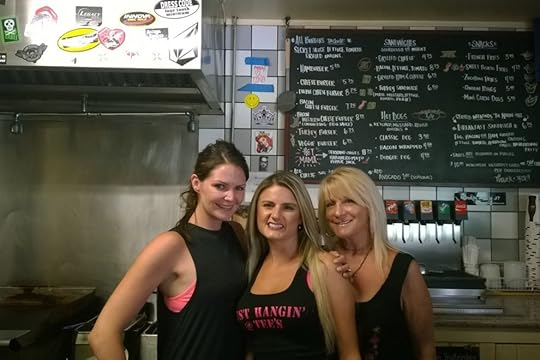 The all-female staff at Tee’s on the Green will make you the best burger ever!
The all-female staff at Tee’s on the Green will make you the best burger ever!
Photo courtesy of Lisa Niver
Come by to try the latest creation, and find your personal favorite. Try the original cheeseburger, and relax with a pitcher of beer, as you watch the sky change colors with the sunset. They are very concerned about the small details here, as they love food and want it up to their standards and yours. Sometimes there is specially made tuna fish with Hot Mama Sauce.
While you are here, try out the latest craze: disc golf! The Verdugo Par 3 is a public course open until 9:30 p.m. You play with a Frisbee, and it’s really fun! Try out the fastest growing sport in America, which was invented nearby in Oak Grove.
Enjoy this hidden gem before everyone finds out about Tee’s on the Green, which is only 25 minutes from Los Feliz and 15 minutes from Echo Park. Come meet other people who are passionate about food, or just stop by to sit under the trees in an Adirondack chair and enjoy the people watching.
The post USA Today: Tee’s On the Green appeared first on We Said Go Travel.
We Said Go Travel
We Said Go Travel is a global community of over sixteen hundred writers with articles from every continent.
Stories are shared with photos and video from a perspective of the transformative power of travel. We Said Go Travel has hosted live and online events as well as travel writing contests around the world. ...more
- Lisa Niver's profile
- 57 followers


